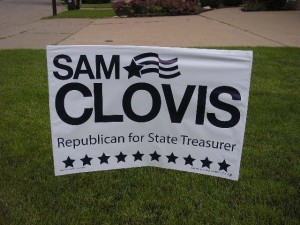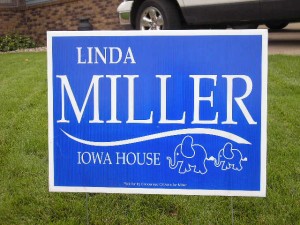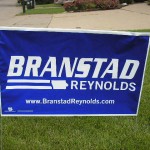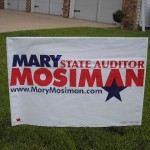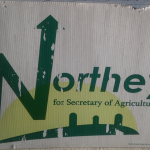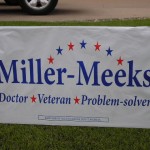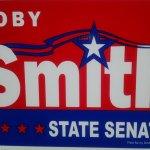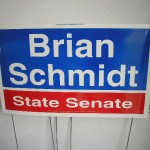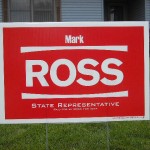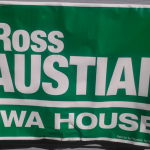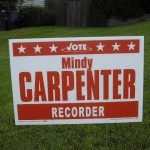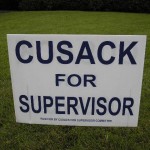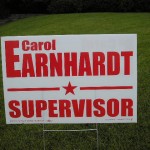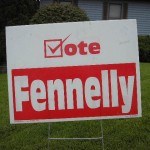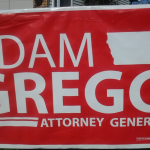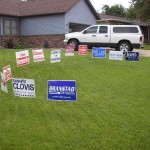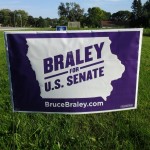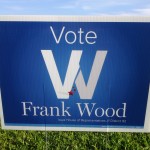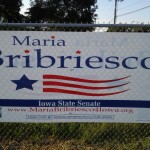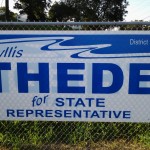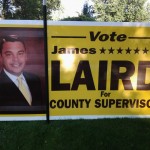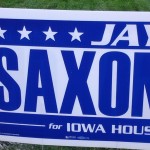How does it feel to be leader of a political party, Republican or Democrat, and realize that so many politicians and consultants interpret clear consistent association with such trepidation (or perhaps as only marginally useful) that when it comes to the general election they limit any association with the party to the general public? How do they justify spending money donated to the party on such candidates and not requiring some consistent association, not necessarily everywhere, but somewhere?
We challenged readers a couple of weeks ago to predict the number of Republicans running on the Scott County ballot that would have some indication of an association with the Republican Party, either on yard signs or literature or web site, even if it is just a commonly recognizable symbol or logo. We guessed maybe four (15% – 20%) would have something on their yard signs and six on their readily available literature. We did so not having seen the current panoply of candidate signs or literature, only from past observation. If you picked less you are probably right.
We checked signs available at Scott County Republican (SCR) HQ, the literature and bumper stickers for public consumption there, and also clicked through what individual candidate Web sites exist. Of the material available at SCR-HQ we found indications of only three candidates who included some direct indication that they are Republicans in their literature, yard signs or in anyway prominent on their Web pages.
From our more limited research regarding Democrats, their candidates appear to be no better or worse or different, depending on how you view the matter, in their willingness to display party affiliation. Few members of either tribe are willing to acknowledge party affiliation.
Space and graphic design with today’s printing technologies cannot seriously be considered an excuse for not having some indication other than perhaps on a bumper sticker. We are not referring to some big R (or Big D) dominance with small name identification for the candidate. We are referring as a matter of this objective electioneering study to even a small indication observable at a glance, the barest acknowledgments of association with party.
So where is the pride of party, or the courtesy to acknowledge who brought you, who authorized your name on the ballot? We think we can convey the consultants or conventional wisdom behind this . . . words to the effect . . . party ID doesn’t bring anything, it isn’t necessary, it may turn-off people who might otherwise vote for you.
Such presumptions have remained unexamined for two or three decades
The presumptions require the belief that the people who have some real animus toward a certain party will magically not vote straight party when they go to the voting booth or fill out their absentee ballot and, low and behold, see the candidates’ party identifications. It is all based on anecdotal stuff that gets passed around about the occasional person who might remark something about not generally liking X party but telling the candidate “he likes what he has to say.” All good but no reason to remove party ID when it could prompt the voter to reconsider Republicans in general. Not having party identification is just as likely to make the same number suspicious of the candidate’s honesty and forthrightness. And the positive impression on those with hard core party affinity is jeopardized.
Maybe we should be concerned about what we wish for. Some candidates do not deserve the association, or have no intention of honoring it, and they end up sullying the Party name. But our wish is not in isolation. That there should be some party discipline has been a long standing advocacy of ours.
Many will think it an insignificant matter or perhaps a cleaver accommodation. We do not know how significant it is electorally, anymore than the practitioners do, but we do find the current universality of it telling. Obviously the candidates and or their consultants believe association with party is a general electoral negative. A general thought that association is neutral is unsupportable as one would not see such a universal dearth of the inclusion of party identification or, in so many cases, apparent scrupulous avoidance.
Party response
We believe local and state party leadership is too weak to “insentivize” acknowledgment of party by the candidates, or worse from the standpoint of party building, supports their detachment. By the way, parading an elephant or float, as is done locally, with candidate signs attached only indicates a one way attempt at association of party to candidate. It begs the main question posed in this article regarding the lack of candidate inspired association to party. Note that various candidates have their own parade entries, and they are not promoting party.
Candidates who feel direct party association weakens them would rather have parade participants fleshing out their numbers and showcasing them. They figure they have the hard core Republicans and don’t want to, in their mind, scare away the no party types. An absurd formulation given that when it comes time to vote, they are listed on the Republican line. Any “independent” who is that instinctively hostile is not someone to design ones campaign around.
Candidates clearly associating with party for the general election:
The three Republicans who had pride of membership or at least a view not to run from or obscure any pre-ballot identification with party identification are State Treasurer candidate Sam Clovis (who indicated his affiliation on signs, bumper stickers, literature and his Web site) and State Legislative candidate Linda Miller , who either indicates Republican outright or symbolizes it prominently. William Cusack, candidate for County Supervisor, indicates an “R” on the literature available at SCR-HQ but not on his yard signs. He has no Web site that we could find.
We did not find literature last week for County Treasurer candidate Bill Fennelly and the yard sign picked up by us did not have any Republican identification however we do remember the stylized R being a part of older signs displayed in the past. No Republican identification appears on the newer signs available in the SCR HQ vestibule.
Above — the only Republican candidates we found indicating they are Republican on their yard signs.
The Branstad/Reynolds campaign, our U.S. Senate candidate Joni Ernst, our nominee for Congress Dr. Miller-Meeks, the party’s candidates for Secretary of State, of Agriculture, Auditor, Attorney General, other state legislative candidates and county candidates who pursued and received the Republican nomination, none of them have an indication of party affiliation on their yard signs nor, after more than cursory examination, in any way obvious on their general public literature or on their Web sites. For most it is simply not present.*
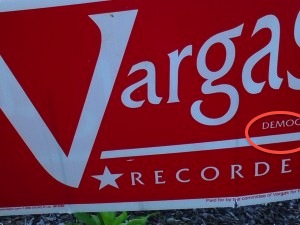 It is not like there is not enough room to incorporate some indication perhaps if only to the extent that Democrat Recorder candidate Vargas somewhat tepidly did. Hers is the only Democrat we have found so far willing to display generally that they are a Democrat on a yard sign. Our recollection is that back in the day it was thought suspicious not to include party identification.
It is not like there is not enough room to incorporate some indication perhaps if only to the extent that Democrat Recorder candidate Vargas somewhat tepidly did. Hers is the only Democrat we have found so far willing to display generally that they are a Democrat on a yard sign. Our recollection is that back in the day it was thought suspicious not to include party identification.
Dear Readers: For kicks and giggles here are the rest of the yard signs we have seen so far in Scott County. Look for your favorite party if you please, but don’t strain too hard, we already did and there is no indication of party affiliation. Keep in mind that this dearth of association with party for the most part extends to their literature and their Web sites, if they have one.*
Democrat Signs: So far driving around Davenport we have seen as many of them as Republicans, however to this point in the election cycle we have maybe one Hatch and one or two Loebsack signs. We see or expect few signs in West Davenport because Republicans have no candidates for the legislature which, were they to exist, would tend to pump up the volume for both parties.
Not shown, a Kinzer (D) for Supervisor sign we only were able to catch a glimpse of.
It should be mentioned that, observing from our travels so far, Republicans have the clear overall dominance of signs on thoroughfares, (all races combined). The Bribriesco vs Smith State Senate race appears the most competitive in signage display, but with Smith now getting many signs up, perhaps surpassing her. **
So why the general and apparent scrupulous avoidance of party association by so many candidates? Our focus here being Republican dynamics.
For the most part frankly it is simply because of the weakness of party leadership in requiring some acknowledgment from candidates for benefits received. For some consultants and candidates it is the feeling that party leadership can be ignored because they won the primary and the party has nothing all that useful to offer post primary (this is probably much less a factor with Democrats). In that regard it is not like the Republican Party invests anything significant in building the good name of the party and defending and advocating policies on the candidates’ behalf. All or most political argumentation is left to helter-skelter candidate related communications or that of issue groups.
For some candidates it may be because they believe elections are only about them, not consistent policy or even team focus to accomplish good things. Others, the newer candidates being most vulnerable and excusable, have been given shoddy, superficial, unsupportable and unexamined advice and assumed it to be the way to go.
A common undercurrent to all recommended avoidance of party identification is the willingness to pander for votes to the dull brained idea among too many no-party types, to wit: “I vote for the “man” and not the party.” Well with those political nitwits if they like the man they will ignore the party anyway. Likeability and party association are not mutually exclusive except when candidates and party work to make it so. A subset of that attitude is pandering to the thought that the two main parties’ politicians are all alike, so vote for the “man.” Unfortunately too many politicians do ignore what the party supposedly stands for (as do too many party leaders ) feeding that particular anti-party or indifferent to party attitude.
In our scheme of how things ought to be, the start of politics should be encouraging the plebiscite to voting for the party because of the key positions that the party candidates are expected to hold and pursue. Those positions are made majority issues with the help of party auspices, something not done much at all at any level today. Candidates are helped in their presentation and association with party ideals by the party and by the party effectively challenging and arguing against big government liberalism and crony capitalism. Party leadership is miserably lacking at this when it isn’t greatly compromised. The party leadership cannot effectively enhance straight ticket voting for Republicans (presuming the party stands for important things) while ignoring the propensity of Republican candidates to ignore or publicly avoid the party.
R Mall
* We looked pretty closely at Web sites of those candidates that had them. We were flabbergasted to find so many candidates appearing to scrupulously avoid the word Republican or any symbolization. We first looked at the Home pages and only found association present on the Clovis for State Treasurer campaign site and that of State House candidate Linda Miller. Incredibly for the rest you would be hard pressed to find a Republican reference or symbol. The Branstad- Reynolds campaign makes no obvious indication of association at this point. Their web site’s news release page is not an exception. The campaign created press releases there refer to Branstad – Reynolds as the Republicans but that is only because the PR people are trying to write the release for the news outlet in journalistic form as a convenience. That is the horn-book way of writing press releases in the hope it will be adopted whole hog by busy outlets. Any editor worth their salt would include it anyway and the candidates’ PR people realize that.
** This article may be updated periodically

